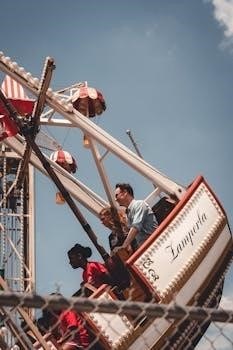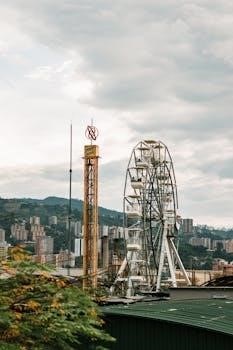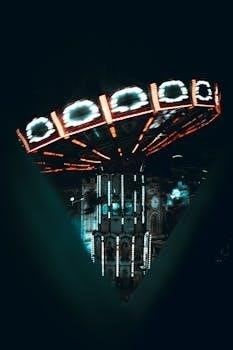K’NEX Ferris wheels provide an engaging building experience, blending creativity and engineering․ These sets feature rods and connectors, allowing for construction of functional and often motorized models, offering unique challenges and enjoyment․
Overview of K’NEX Construction System
The K’NEX construction system is characterized by its unique approach to building, using rods and connectors that interlock to create structures․ Unlike traditional blocks, K’NEX allows for the creation of dynamic, moving models․ The system’s versatility is evident in the variety of components, including different lengths of rods, various connector types, and specialized pieces․ These parts facilitate complex designs, from simple geometric shapes to intricate mechanical systems․ The connectors are designed to snap onto the rods, creating a firm yet flexible structure․ The use of spacers is often crucial, ensuring proper alignment and preventing binding in moving parts․ The system also integrates motorized components, which when combined with the structural pieces, enable the construction of dynamic models like Ferris wheels․ The K’NEX system is not just about building; it’s about understanding how pieces fit together to create functional structures, a great introduction to mechanical engineering concepts․

Specific K’NEX Ferris Wheel Models
K’NEX offers a variety of Ferris wheel models, each with unique features․ These range from the impressive 6-foot tall structure to smaller musical and classic designs, providing options for different interests and skill levels․
6-Foot Ferris Wheel (Model 89790)
The K’NEX 6-Foot Ferris Wheel, identified as model 89790, is a notable set known for its impressive size and complex construction․ Standing at approximately 1․8 meters tall, this model presents a significant building challenge and offers a rewarding experience upon completion․ The online images and instructions may sometimes lack clarity regarding the center rotation, which can be a source of confusion for builders, especially concerning the combination of the 6 center rotation points․ It’s crucial to carefully follow the included step-by-step guidance, often provided in a large-format instruction book․ Some users have noted issues with missing parts or battery housing units, highlighting the importance of verifying all components before starting the build․ Despite these challenges, the 6-Foot Ferris Wheel remains a popular choice for those seeking a substantial K’NEX building project․ Additional tips and clarifications might be available through the official K’NEX website, or from community forums․
Musical Ferris Wheel (Model 15133)
The K’NEX Musical Ferris Wheel, model number 15133, offers a unique twist to the traditional Ferris wheel building experience, incorporating music into its functionality․ This model requires careful attention to the provided instructions, available for download as a PDF, ensuring each step is followed correctly to achieve proper assembly and musical operation․ The instructions guide builders through the construction of the wheel, the seats, the motor installation, and the stand, culminating in the final assembly․ Battery installation, typically involving the use of a small Phillips head screwdriver to loosen the battery compartment screw, is necessary for the musical feature to function․ The musical aspect sets this Ferris wheel apart, making it an enjoyable and engaging project․ It may also be known as the Amusement Park Musical Ferris Wheel (15137)․ Additional support can be found online and through K’NEX resources, offering a seamless building process․
3-in-1 Classic Amusement Park Ferris Wheel (Model 17035)
The K’NEX 3-in-1 Classic Amusement Park Ferris Wheel, identified by model number 17035, provides a versatile building experience․ This set allows for the construction of not just one, but three different amusement park models, enhancing its play value․ The primary build, a classic Ferris wheel, is detailed in its instruction manual, which is available for download online․ These instructions guide users through the assembly process, ensuring correct usage of connectors and rods․ In addition to the Ferris wheel, the set can be transformed into alternative models, using the same parts․ Builders are encouraged to use the website to find instructions for the alternate models․ This 3-in-1 aspect of the set promotes problem-solving and creativity․ The set’s versatility and engaging nature make it a popular choice among K’NEX enthusiasts․ The detailed step-by-step guidance is crucial to the successful building process․
2-in-1 Ferris Wheel (Model 14579)
The K’NEX 2-in-1 Ferris Wheel, model number 14579, offers builders the opportunity to create two distinct models from a single set, adding to its versatility and play value․ The primary build is, of course, a Ferris wheel․ Detailed instructions for this model are available online, providing step-by-step guidance through the entire assembly process․ Builders are advised to follow the instructions carefully, paying attention to the correct placement and orientation of connectors and rods․ The second build is an alternate model, and its instructions can also be accessed online, expanding the set’s creative possibilities․ This 2-in-1 feature engages users, encouraging them to think critically and explore different construction techniques․ The downloadable instruction manual assists in the successful completion of both models, ensuring a rewarding building experience․ The set’s versatility makes it a popular choice among K’NEX fans․ This model encourages innovative building approaches․

Assembly Instructions and Tips
When assembling K’NEX Ferris wheels, following the detailed instructions is crucial for a successful build․ These models often require careful attention to ensure proper connections and functionality, especially with motorized parts․
Importance of Following Step-by-Step Instructions

The construction of a K’NEX Ferris wheel, be it a 6-foot giant or a smaller musical model, relies heavily on meticulously following the provided step-by-step instructions․ These instructions are not mere suggestions; they are a carefully crafted roadmap that ensures the structural integrity and smooth operation of the finished model․ Each step builds upon the previous one, and a deviation from the prescribed order can lead to instability, misalignment, or, in the case of motorized models, a failure to function correctly․ Missing a crucial connection or placing a piece in the wrong position can result in significant frustration and a need to backtrack, disassembling parts of the structure to correct the error; The K’NEX system is designed with precision, and the instructions are tailored to guide builders through that precision․ The proper orientation of connectors, the insertion of rods, and the use of spacers all contribute to the overall success․ Therefore, taking the time to thoroughly understand each step is not just recommended; it’s essential for achieving a successful and enjoyable building experience with your K’NEX Ferris wheel․
Battery Installation for Motorized Models
For K’NEX Ferris wheel models that include a motor, proper battery installation is crucial for operation․ These models typically require two AA batteries (LR6), which must be inserted into the designated battery compartment with correct polarity․ The compartment usually features a small screw that needs to be loosened with a Phillips head screwdriver to access the battery slots․ The polarity (+/-) is clearly marked inside the compartment to ensure the batteries are correctly positioned․ Incorrect placement can cause the motor to malfunction or not function at all․ Always use fresh batteries to guarantee optimal performance and prevent issues․ Before starting the installation, double-check the battery type and the compartment’s polarity markings․ Securely close the compartment after inserting the batteries, ensuring the screw is tightened․ Never force the battery into the slot; if resistance is met, check the polarity again, and be sure to use the correct batteries․ This will help avoid damage to the compartment or the motor․ Proper battery installation is an essential step in getting your motorized K’NEX Ferris wheel running smoothly․
Connecting Rods to Steel Rods/Orange Connectors
Connecting rods to steel rods or orange connectors is a fundamental step in assembling a K’NEX Ferris wheel․ This process often involves carefully aligning the rods with the connectors and ensuring a secure fit․ The steel rods usually serve as axles or structural supports, while the orange connectors provide a stable base for attaching other components․ When making these connections, it’s important to push firmly until you hear a click, indicating that the rod is properly engaged with the connector․ If you encounter difficulty, double-check the alignment of the rod and the connector, ensuring no obstructions are present․ Sometimes, it may be necessary to rotate the rod slightly to find the correct insertion point․ Always follow the step-by-step instructions in your K’NEX manual, which will illustrate the specific connections required for your Ferris wheel model․ These connections are essential for creating a stable and functional framework for your K’NEX project․ If the connection seems loose, examine both the rod and connector for any damage or debris that might be hindering a secure fit․

Troubleshooting Common Issues
Building K’NEX Ferris wheels can sometimes present challenges․ Common problems include missing pieces and difficult assembly sections․ Knowing how to address these issues ensures a smoother building experience and a successful project․
Dealing with Missing Parts
Discovering missing parts during a K’NEX Ferris wheel build can be frustrating, but it’s a common issue that can be resolved․ Begin by thoroughly checking all packaging materials and the surrounding work area․ Sometimes, small pieces can easily get overlooked or stuck in the box․ If a part is genuinely missing, consult the instruction manual, which often includes a parts list and may have a customer service contact for replacements․ Alternatively, some K’NEX user groups or online forums might offer advice on finding substitutes or even obtaining spare parts from fellow enthusiasts․ It’s also worth checking the official K’NEX website, as they sometimes provide a parts request form․ Keep in mind that identifying the exact missing piece is crucial for a successful replacement, so a picture is often very helpful․ Patience and persistence are important when dealing with missing K’NEX pieces, as solutions are usually available․
Addressing Difficult Assembly Sections
Encountering tricky assembly sections is a normal part of building K’NEX Ferris wheels․ When a step seems particularly challenging, taking a break can often provide a fresh perspective․ Review the specific instruction steps carefully, ensuring that all pieces are oriented correctly and connected in the proper sequence․ Pay close attention to diagrams, and look for any subtle details such as the position of the connectors or the direction of the rods․ If the manual doesn’t provide enough clarity, searching for online videos or forums might offer visual aids and tips from other builders․ Consider using tools, like a small screwdriver to gently loosen parts if needed․ Also remember that sometimes a slight adjustment or rotation of a part can make a big difference․ Don’t get discouraged; difficult sections can be overcome with patience, careful observation, and the resources available․
